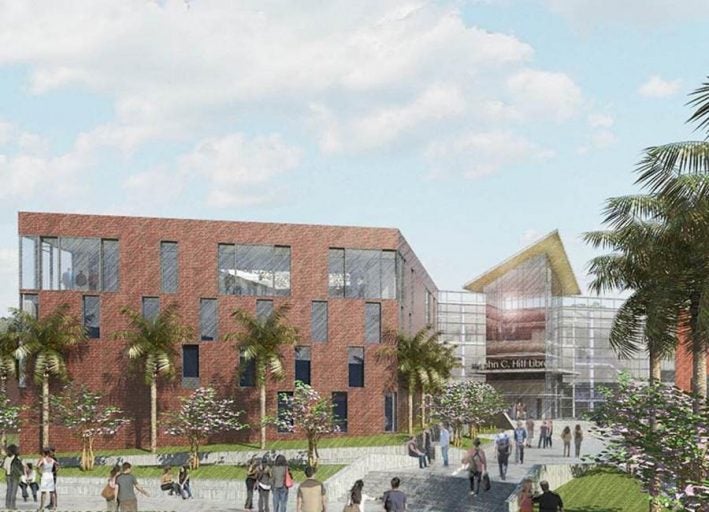UCF’s first building – now called the John C. Hitt Library – is about to undergo a complete transformation that will provide new amenities for students such as an automated book-retrieval system, additional open shelving for materials, 24-hour study rooms, and space for researchers to collaborate.
The original library was built in 1967 and more than doubled in size with an expansion in 1984. Beginning within the next month, construction will start to enlarge and renovate the building into a “21st Century Library that is more than a setting to access information,” according to the plans guiding the project, adding that the library will play an active role “in the process of knowledge creation.”
“When the library opened, services centered around the resources – mostly print – that were found using a card catalog. Services are now designed around the needs of the user, providing access to countless resources, print and electronic,” said Meg Scharf, associate director for communication, assessment and public relations at UCF Libraries.
“The John C. Hitt Library is evolving into an exciting and creative learning environment that fosters new knowledge. Students need space for collaborative work, as well as space that emphasizes individual research and reflection.”
The project will be in three phases to serve the more than 63,000 students of the second-largest university in the nation.
The first part, which will add to the library’s footprint to the north of the current building toward the Student Union, consists of new construction for 113,000 square feet of space for the three-story automated-retrieval center; renovations to restrooms, elevators and fire sprinklers on the top four floors of the library; a redesign of the fifth-floor quiet reading room, and an increase in the number of needed power outlets for students to recharge phones and computers.
The work is expected to be completed by fall 2017, said Maria Teimouri, project manager in facilities planning and construction.
Phase 2 will add a connector building between the existing and new buildings, and Phase 3 will include a comprehensive renovation of the current library. Start dates for those parts of the project will be determined later. The retrieval system will be temporarily connected to the second floor of the library by a bridge until the connector building is completed.
When the project is complete, not all the library’s 1.25 million volumes will be stored for retrieval by the new automated system. About 300,000 of the most current and heavily used volumes and those most suited to browsing will be kept on the open shelves. That includes some of the general collection, reference materials and other items.
Requests for other bound volumes will be made using the library’s online catalog. The items will be retrieved automatically and delivered to the circulation desk in five to 10 minutes.
The project is designed to improve service for users, who made nearly 1.26 million visits to the building during 2014-15. Many other users access the library’s services from home, classrooms and offices. The John C. Hitt Library contains the bulk of the university’s collection, currently at 1.3 million volumes. There are also about 144,000 e-books in the collection and another 231,000 materials in other university libraries.
“The expansion and renovations involved with the 21st Century Library project will provide UCF students and faculty with new learning spaces, updated technology, and convenient access to resources necessary to continue to grow as an institution committed to collaborative research and academic excellence,” said Susan Quelly, an assistant professor in the College of Nursing and a member of the UCF library advisory committee.
UCF’s 21st Century Library will feature:
